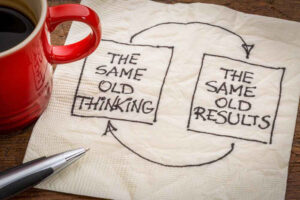Before you read the rest of this post, I would like you to engage in a brief reflection exercise. Close your eyes and think about where you spent your time over the last two weeks at work. How much of your time was spent in meetings? How many of the meetings were productive with clear agendas, specific actions assigned to participants and specific deadlines for those action items? How many meetings, upon reflection, were repetitive, had no agendas, did not really require your presence or could have been handled by an email or brief conference call? Did you have enough time over the last two weeks to actually do all the work your job requires during the workday or did it spill over into your personal time?
What were the results of your reflection exercise? Any surprises? Epiphanies? How is this affecting your morale? The vast majority of professionals I engage with have a high degree of frustration with the structure, volume and even the necessity of many of the meetings they are forced to attend each week. They will often acknowledge that they may be contributing to the problem themselves with how they conduct meetings which they are responsible for leading. I have written extensively in the past on best practices for fixing dysfunctional business meetings, better time management and thwarting time thieves. All of this past blog content and certain chapters in my most recent book can help you effectively improve how you structure (and lead) meetings, but I would like to elevate awareness in this post about why we have such widespread challenges with meetings.
Normalized Defects and Accidental Values
A few years ago I wrote about the concept of the “normalization of defects” in business after learning from my friend Steve Moore about NASA’s uncovering of the imbedded defects, known by many, in the space shuttle program that led to the tragic Columbia and Challenger shuttle explosions. Normalized defects can often be defined as those behaviors and actions we do and tolerate, even though we likely know at some level they are wrong. Steve did a wonderful job of applying this concept to business in some of his consulting work. In business, you often hear this described as “that is just the way we do things” around here and these defects can become embedded in a team or company culture over time. Consider our challenges with meetings through the prism of normalized defects: we likely know we have a big issue with unproductive meetings, but have gotten used to it over time and may not know how to change. We may even fear changing because we have gotten so used to the widespread “meeting culture” we have created and may be skeptical of more effective and efficient approaches. Broadly acknowledging at all levels of an organization the widespread nature of a normalized defect like dysfunctional and unnecessary meetings (and committing to substantive change) can be a significant step forward in fixing the problem.
I came across a post on HBR.com by best-selling author Patrick Lencioni several years ago where he discussed the various types of values in an organization. I was particularly drawn to his description of “accidental values”. From Lencioni:
“Accidental values arise spontaneously without being cultivated by leadership and take hold over time. They usually reflect the common interests or personalities of the organization’s employees. Accidental values can be good for a company, such as when they create an atmosphere of inclusivity. But they can also be negative forces, foreclosing new opportunities. Managers always need to distinguish core values from merely accidental ones, as confusion here can be disastrous.”
He also wrote about connecting your core company values to where you spend your time each day. It would seem logical that we would spend the majority of our time on activities that reflect our company values, correct? Well, a recent extensive survey of meetings and their impact on where we spend our time determined that 71% of business meetings were deemed unproductive and upper management spent over 50% of their time each week in meetings. The survey also went into great detail about the millions of work hours lost to unproductive meetings and the billions of dollars lost each year on them (two of the many financial reasons why we should take on the meeting dilemma without delay). This could lead us to conclude that, perhaps, meetings have become an accidental value in many companies based on this exorbitant time investment. I know leaders right now who would say they are in meetings 70-90% of their time each week. Do we really want to communicate internally to our employees or externally to our customers and clients that meetings have become a value of our company? Of course not…but the problem still remains.
What Can We Do?
There are countless books and articles on best practices for improving meetings or implementing better alternatives. There is value in learning these approaches and I shared links in the second paragraph to a few posts I have written. My challenge to leaders and aspiring leaders who read this post is to start having respectfully candid conversations in your companies at all leadership levels on this topic. Challenge the status quo and look at root causes for your meeting issues. Ask probing questions. Are our meetings effective and efficient? Are there better alternatives like email, easily accessible dashboards for status updates, or brief conference calls? Why do we have so many meetings? Do we have adequate time to do our work and if not, are our teams taking work home? Is there a good reason why we treat some meetings as sacred? Can we embrace the popular trend of one or two meeting-free days during the week? What are we neglecting or ignoring regarding the business and our people by spending time in unproductive meetings?
Although I am a firm believer in the positive ripple effect one leader or team can have on others in an organization when they model changing attitudes, helpful behaviors and new tactics, I think fixing meeting madness will require a more systemic approach. Treat it as a cultural issue (which it is) and meet it head on from the top of the organization down. Be willing to question the causes of the disease and come up with large-scale cures before putting additional energy into addressing the symptoms.
A Much-Needed Outcome
I was chatting with a senior HR executive client this morning and mentioned the topic of this post to her. She reminded me of the obvious and much-needed outcome we will have if we succeed in fixing the dysfunctional meeting cultures that exist in most companies: we will have more time for the meetings that matter most with our colleagues and team members. I hear consistently from leaders that they have not been spending enough quality 1:1 time with peers or members of their teams. The pandemic had an obvious negative impact, but as we move into a post-pandemic phase we can (must) begin improving relationships strained by two plus years of remote work. We can invest in improving teamwork and trust with our colleagues. We can invest in developing our people and seeking developmental conversations to assist our own growth and development. If you could reclaim 5-10 hours of your week by addressing the challenges of your company’s meeting culture, how would you invest this gift of time?
Meetings are obviously a necessary part of business and I am certainly not advocating for their complete elimination. But, I hope you will agree we can do better and make significant improvements. Some meetings are just unnecessary. Some are poorly run and can be improved. Some can be replaced by more effective and less time-consuming alternatives. Senior leaders need to recognize the systemic challenges and advocate for big changes. I hope this post stimulates some new thinking and inspires you to engage in a different conversation about meetings in your company. The applause will be deafening if you get it right.
Good luck.






